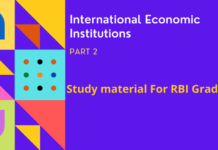What is Foreign Portfolio Investment ?
Foreign portfolio investment (FPI) consists of securities and other financial assets passively held by foreign investors.It does not provide the investor with direct ownership of financial assets and is relatively liquid depending on the volatility of the market.
- FPI is part of a country’s capital account and is shown on its Balance of Payments (BOP).
The BOP measures the amount of money flowing from one country to other countries over one monetary year. - The investor does not actively manage the investments through FPIs, he does not have control over the securities or the business.
- The investor’s goal is to create a quick return on his money.
- FPI is often referred to as “hot money” because of its tendency to flee at the first signs of trouble in an economy.FPI is more liquid than FDI.
Who are Foreign Portfolio Investors?
Foreign Portfolio Investors includes investment groups of Foreign Institutional Investors (FIIs), Qualified Foreign Investors (QFIs) (Qualified Foreign Investors) and subaccounts etc.NRIs doesn’t comes under FPI.
After the SEBI guidelines 2019, FPI also includes Asset Management Companies, Banks, Pension Funds, Mutual Funds, and Investment Trusts as Nominee Companies, Incorporated / Institutional Portfolio Managers or their Power of Attorney holders, University Funds, Endowment Foundations, Charitable Trusts and Charitable Societies etc. Sovereign Wealth Funds are also regulated as FIIs.
Some Important terms :
- Rights Issue : A rights issue is when a company offers its existing shareholders the chance to buy additional shares for a reduced price.A company would offer a rights issue in order to raise capital which can be used to clear its debt obligations, acquire assets, or facilitate expansion without having to take out a loan from a bank.
- Stake Sale : Stake sale refers to a company selling its equity holding in a particular company to another company. It is the disinvestment of a company’s shares. It also represents the end of the investment process in a particular company. For example, Let’s say i have 40% stake holding in company A ; I am selling my 40% stake to any another company let’s say B.
- Qualified Foreign investor: QFI is an individual, group or association which is a resident in a foreign country. The QFI should compliant with the Financial Action Task Force standard and should be a signatory to the International Organisation of Securities Commission.
What is Foreign Direct Investment?
FDI is an investment from a party in one country into a business or corporation in another country with the intention of establishing a lasting interest.Lasting interest differentiates FDI from foreign portfolio investments, where investors passively hold securities from a foreign country.Foreign direct investment can be made by expanding one’s business into a foreign country or by becoming the owner of a company in another country.
- FDI inflow is a route for transferring capabilities, technology, building linkages, business capabilities etc.
- Broadly, FDI includes “mergers and acquisitions, building new facilities, reinvesting profits earned from overseas operations, and intra company loans”.In a narrow sense, it refers just to building a new facility, and lasting management interest.
- There are two routes by which India gets FDI:
1) Automatic route: By this route, FDI is allowed without prior approval by Government or RBI.
2) Government route: Prior approval by the government is needed via this route. The application needs to be made through Foreign Investment Facilitation Portal, which will facilitate the single-window clearance of FDI application under Approval Route.
Under New FDI Rule:
1. An entity of a country, which shares a land border with India or where the beneficial owner of an investment into India is situated in or is a citizen of any such country, can invest only under the Government route.
2. A transfer of ownership in an FDI deal that benefits any country that shares a border with India will also need government approval.
India shares land borders with Pakistan, Afghanistan, China, Nepal, Bhutan, Bangladesh and Myanmar.
3. Investors from countries not covered by the new policy only have to inform the RBI after a transaction rather than asking for prior permission from the relevant government department.
Difference Between FDI and FPI
| Foreign Direct investment | Foreign Portfolio investment |
| Active investment | Passive investment |
| Long term capital | Short term capital |
| Invests in financial and non- financial assets | Invests only in financial assets |
| Ownership and managerial control | Only ownership |
| Entry and exit barriers | Entry and exit very easy |
What is Privatisation?
The transfer of ownership, property or business from the government to the private sector is termed privatization. The management does not rests with the government.
The process in which a publicly-traded company is taken over by a few people is also called privatization. The general public is barred from holding stake in such a company. The company gives up the name ‘limited’ and starts using ‘private limited’ in its last name.
The objective is often to increase government efficiency; implementation may affect government revenue either positively or negatively. Privatization is the opposite of nationalization.
What is Disinvestment ?
Disinvestment means sale or liquidation of assets by the government, usually Central and state public sector enterprises, projects, or other fixed assets.
The government undertakes disinvestment to reduce the fiscal burden on the exchequer, or to raise money for meeting specific needs, such as to bridge the revenue shortfall from other regular sources. In some cases, disinvestment may be done to privatise assets. However, not all disinvestment is privatisation.
Some of the benefits of disinvestment are
- That it can be helpful in the long-term growth of the country;
- It allows the government and even the company to reduce debt.
In this, management and ownership rests with the government.
KEY DIFFERENCES :
- When more than 51% of the stake is sold by the government of a public sector undertaking, to the private individuals or firm, the process is termed as privatization. On the other hand, Disinvestment implies to the disposal of assets by the government or any other organization, leading to a change in ownership and control.
- Privatization involves a change in ownership, whereas Disinvestment involves dilution of ownership.
- In privatization, the government sell more than 50% of its shareholding, while in case of disinvestment shareholding less than 50% is sold by the government.
- Disinvestment refers to the dilution of government shareholding in a public sector entity. However, if the dilution is less than 50%, the management of the enterprise is kept by the government. However, when the dilution of shares exceeds 50%, there is a change in management along with the ownership, which is practically called Privatization.




